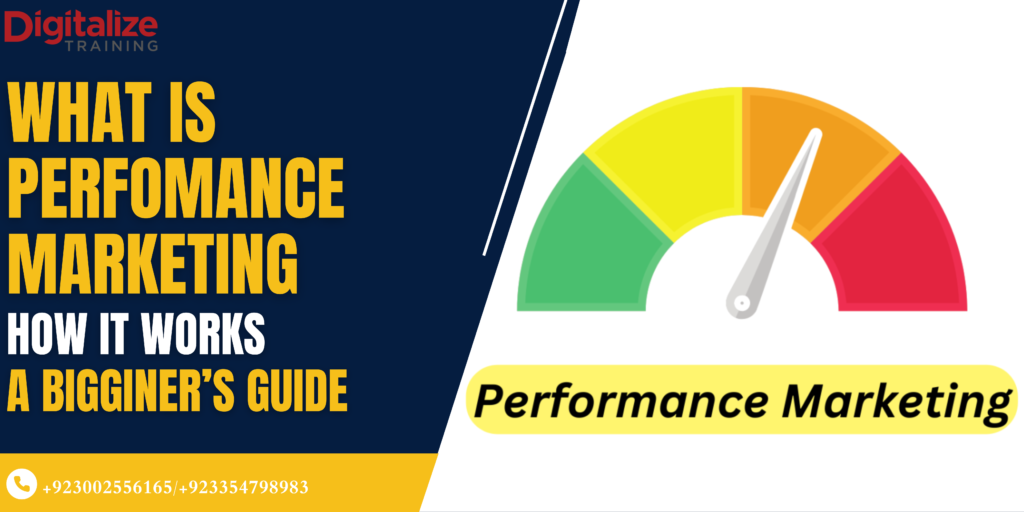
What is Performance Marketing?
Let’s break it down simply. Performance marketing is a way for companies to pay for ads based on how well they perform. Instead of paying upfront, businesses pay only when a specific action happens—like a click, a sale, or a sign-up. Think of it like this: you only pay for your pizza when it gets delivered hot and tasty, not before!
Performance Marketing vs. Digital Marketing
You might be thinking, “Isn’t this the same as digital marketing?” Well, not exactly. Digital marketing includes everything from social media posts to blog articles and email campaigns. Performance marketing is a part of digital marketing but focuses solely on results.
In performance marketing, if the ad doesn’t deliver results, you don’t pay. This makes it different from the broader world of digital marketing, where you may pay for ads whether they work or not.
It’s a great skill for business owners and job seekers with a great pay scale. If you want to be skilled at this you can get business training on a live account from a digitized training institute.
Benefits of Performance Marketing
Why should you care about performance marketing? Well, here are some good reasons:
It’s Cost-Effective: You pay only when the desired action occurs, which helps you get more bang for your buck.
Results-Driven: It keeps you focused on what works and lets you quickly drop what doesn’t.
Data-Backed: You can track every action, from clicks to sales, allowing you to see what’s working and improve over time.
How Does Performance Marketing Work?
Imagine you’re running an online store selling sneakers. Instead of paying a bunch of money for ads hoping they’ll bring in sales, performance marketing lets you pay only when people actually buy your sneakers, click your ad, or complete a form with their contact details.
The key is tracking every action people take on your ads. Each action is like a puzzle piece that helps you understand what works and what doesn’t. Once you know that, you can focus on what’s bringing you the most sales or leads, making your marketing smarter and more efficient.
Performance Marketing Channels
So, how do you get started? Several channels make up performance marketing. Let’s break them down:
- Influencer Marketing
Influencer marketing is when businesses partner with influencers—people with a big online following—to promote their products. The business only pays the influencer if their followers take action, like clicking a link or making a purchase.
- Paid Marketing and Advertising
This is what most people think of when they hear “ads.” You run an ad and pay only if someone clicks on it or buys something. This includes Facebook Ads, Google Ads, and many other platforms.
- Search Engine Marketing (SEM)
SEM is all about promoting your business on search engines like Google. You pay when people click on your ad after searching for something related to your business.
- Native Advertising
Native advertising blends into the content around it, making it look less like an ad and more like a part of the page. You pay only if someone interacts with your ad by clicking or taking action.
- Social Media Marketing
Using platforms like Instagram, Twitter, or Facebook to run ads, social media marketing lets businesses pay based on how well the ads perform. The goal here is usually to get likes, clicks, and shares that drive more traffic to your site or product.
Performance Marketing Examples
Here’s an example to make it clearer. Let’s say you’re selling a new fitness app. You decide to work with a fitness influencer on Instagram. You pay them only when someone from their audience downloads your app. This is performance marketing in action—your money is spent only when the influencer delivers real results, like app downloads or sign-ups.
Another example could be using Google Ads. You set up an ad that shows up when someone searches for “best running shoes.” If they click your ad and buy shoes from your site, you pay a fee. If they don’t take action, you won’t be charged.
How Do You Measure Performance Marketing?
Measuring performance marketing is like tracking your progress in a video game. You need to know how well you’re doing to improve. In performance marketing, everything revolves around ROI (Return on Investment).
Here are some ways to measure business success:
Cost Per Acquisition. (CPA)
This is how much you pay when someone buys something from your website. If you’re selling t-shirts and someone buys one, you pay a small fee to the ad platform.
Pay Per Lead (PPL)
A lead happens when someone fills out a form on your site, like signing up for a newsletter or creating an account. For each lead, you pay a fee, but you get their contact info, which you can use to sell them products later.
Pay Per Click (PPC)
This occurs when you’re charged each time someone clicks on your ad. It doesn’t matter if they buy something or not; you pay just for the click. It’s great for driving traffic to your website.
Pay Per X (PPX)
This is a more flexible way of paying for performance marketing. The “X” can be anything you agree on with the platform, like paying per download, registration, or view.
Wrapping It Up
Performance marketing is a smart, results-driven way of advertising where you only pay for what works. Whether you use social media, search engines, or work with influencers, performance marketing lets you measure every action and get more out of your ad dollars. It’s a great way to take control of your marketing spend and ensure you’re only paying for success.
By using performance marketing, businesses can maximize their return on investment and ensure their marketing efforts are always working to bring in results. So, if you’re just starting out or want to make your marketing more efficient, give performance marketing a try!
